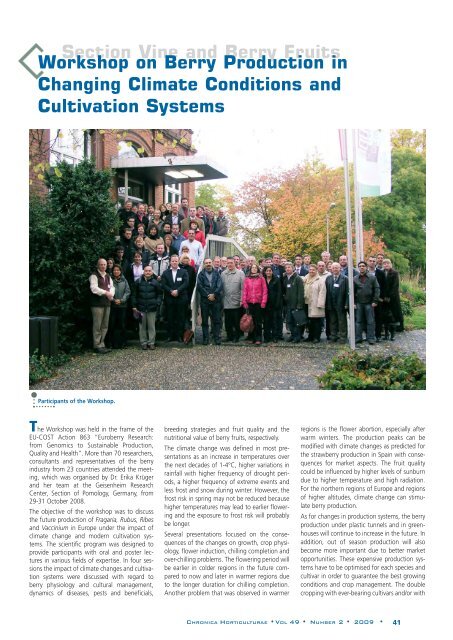Chronica Horticulturae volume 49 number 2 ... - Acta Horticulturae
Chronica Horticulturae volume 49 number 2 ... - Acta Horticulturae
Chronica Horticulturae volume 49 number 2 ... - Acta Horticulturae
You also want an ePaper? Increase the reach of your titles
YUMPU automatically turns print PDFs into web optimized ePapers that Google loves.
Section Vine and Berry Fruits<br />
Workshop on Berry Production in<br />
Changing Climate Conditions and<br />
Cultivation Systems<br />
Participants of the Workshop.<br />
The Workshop was held in the frame of the<br />
EU-COST Action 863 “Euroberry Research:<br />
from Genomics to Sustainable Production,<br />
Quality and Health”. More than 70 researchers,<br />
consultants and representatives of the berry<br />
industry from 23 countries attended the meeting,<br />
which was organised by Dr. Erika Krüger<br />
and her team at the Geisenheim Research<br />
Center, Section of Pomology, Germany, from<br />
29-31 October 2008.<br />
The objective of the workshop was to discuss<br />
the future production of Fragaria, Rubus, Ribes<br />
and Vaccinium in Europe under the impact of<br />
climate change and modern cultivation systems.<br />
The scientific program was designed to<br />
provide participants with oral and poster lectures<br />
in various fields of expertise. In four sessions<br />
the impact of climate changes and cultivation<br />
systems were discussed with regard to<br />
berry physiology and cultural management,<br />
dynamics of diseases, pests and beneficials,<br />
breeding strategies and fruit quality and the<br />
nutritional value of berry fruits, respectively.<br />
The climate change was defined in most presentations<br />
as an increase in temperatures over<br />
the next decades of 1-4°C, higher variations in<br />
rainfall with higher frequency of drought periods,<br />
a higher frequency of extreme events and<br />
less frost and snow during winter. However, the<br />
frost risk in spring may not be reduced because<br />
higher temperatures may lead to earlier flowering<br />
and the exposure to frost risk will probably<br />
be longer.<br />
Several presentations focused on the consequences<br />
of the changes on growth, crop physiology,<br />
flower induction, chilling completion and<br />
over-chilling problems. The flowering period will<br />
be earlier in colder regions in the future compared<br />
to now and later in warmer regions due<br />
to the longer duration for chilling completion.<br />
Another problem that was observed in warmer<br />
regions is the flower abortion, especially after<br />
warm winters. The production peaks can be<br />
modified with climate changes as predicted for<br />
the strawberry production in Spain with consequences<br />
for market aspects. The fruit quality<br />
could be influenced by higher levels of sunburn<br />
due to higher temperature and high radiation.<br />
For the northern regions of Europe and regions<br />
of higher altitudes, climate change can stimulate<br />
berry production.<br />
As for changes in production systems, the berry<br />
production under plastic tunnels and in greenhouses<br />
will continue to increase in the future. In<br />
addition, out of season production will also<br />
become more important due to better market<br />
opportunities. These expensive production systems<br />
have to be optimised for each species and<br />
cultivar in order to guarantee the best growing<br />
conditions and crop management. The double<br />
cropping with ever-bearing cultivars and/or with<br />
CHRONICA HORTICULTURAE •VOL <strong>49</strong> • NUMBER 2 • 2009 • 41
















